LJS 433 Is A 17th Century Japanese Illustrated Treatise On The Diagnosis Of Abscesses And Tumors And
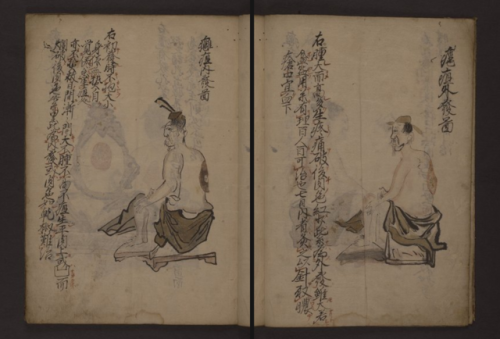


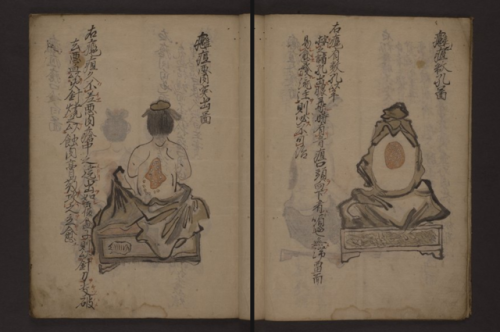



LJS 433 is a 17th century Japanese illustrated treatise on the diagnosis of abscesses and tumors and their treatment. Most of the treatments involve acupuncture or burning different substances near the skin. This manuscript, titled Yoso Zusetsu, is made with paper and written in Chinese script.
When comparing the manuscripts that we’ve looked at this week, it’s interesting to note all of the differences - from the manner in which a body is depicted (size, shape, hair style, details) to the medium and script that is used for the manuscript. Even considering how medical practices differ from culture to culture forms many implications!
I highly recommend checking out other illustrated diagrams in the full digitized version of LJS 433 on Openn: http://openn.library.upenn.edu/Data/0001/html/ljs433.html
or Penn In Hand: http://hdl.library.upenn.edu/1017/d/medren/4827745
*This week, we were taking a look at manuscripts having to do with health, medicine, and human physiology specifically focusing on how bodies are displayed in manuscript illuminations or diagrams across different cultures.
I hope you enjoyed this segment!
More Posts from Philosophical-amoeba and Others

Too much sex causes genitals to change shape, beetle study shows
Sexual conflict between males and females can lead to changes in the shape of their genitals, according to research on burying beetles by scientists at the University of Exeter.
The study, published in the journal Evolution, provides new evidence that conflict over how often mating takes place can lead to males evolving longer penis-like organs and females larger ‘claws’ on their genitalia, within ten generations.
“Our research demonstrates the general importance of conflicts of interest between males and females in helping to generate some of the biodiversity that we see in the natural world. It’s fascinating how genital evolution can happen so fast – in ten generations – showing how rapidly evolutionary changes can occur.”
Paul E. Hopwood, Megan L. Head, Eleanor J. Jordan, Mauricio J. Carter, Emma Davey, Allen J. Moore, Nick J. Royle. Selection on an antagonistic behavioral trait can drive rapid genital coevolution in the burying beetle,Nicrophorus vespilloides. Evolution, 2016; DOI: 10.1111/evo.12938

This is what happens when a carrot is fired at 300 km/hour at an egg, through two sheets of cardboard.
This is what happens if you separate out the two sheets:

The egg survives! This shows how a Whipple shield works, and is what spacecraft use to protect themselves from micrometeoroid impacts in space. When the projectile (in this case a carrot, but in space it could be a speck of paint, a piece of an old satellite, or a bit of space rock) hits the first layer, it’s moving so fast that it starts to vaporise, because the energy of the collision is enough to break almost every bond in the substance.
It then sprays outwards, spreading the force of impact across a much wider area, meaning the second layer can stop it going any further, keeping your egg (or astronauts) safe.
Watch the full video on our YouTube channel.
A Random PSA On The Gei of Geisha - Part 1
The questions surrounding what arts that maiko and geiko practice comes up regularly, and instead of just posting them onto one of the tabs I’d rather lay it out in a post here first. The “Gei” (芸) in Geisha(芸者)/Geiko(芸妓)/Geigi(芸妓) means “Art” and there are many branches and types of art that one can master. For this part we’ll be looking at the direct performing arts that everyone knows the geisha are renowned for: music and dance. Dance - Mai (舞) All traditional Japanese dance styles have their roots in Shinto ceremonies that date back at least two millennia. There are two main styles to traditional dance practiced today: -Noh (能): Originally arrived in Japan from China in the 8th century and developed into the style we know today in the 13th century by Kan’ami (assisted by his son Zeami). Derived from the classical court style dances, it features small, precise movements to tell a story. It can be seen as “boring” or “obscure” if you’re not sure what to look for as you need to understand the movements to appreciate them to the fullest. This isn’t to say that it isn’t beautiful to behold without prior knowledge as it is quite enchanting! Gion Kobu’s Inoue school is part of the Noh tradition. -Kabuki (歌舞伎): Derived directly from Shinto ceremonies, it was created in 1603 by Izumo No Okuni, a shrine priestess who created her own style of dance and performed it on the dry riverbed of the Kamo River. She became so famous that she was invited to perform in front of the emperor! After seeing how popular the style of dance had become rival dance groups sprung up around her and established the kabuki that we know today. The style is known for its dramatic and often “wild” movements that are meant to be appreciated by the common people. Pontocho’s Onoe, Miyagawa Cho’s Wakayagi, Kamishichiken’s Hanayagi, and Gion Higashi’s Fujima schools are part of the Kabuki tradition. Music - Raku (楽) What would dance be without music? Music, like dance, can be broken down into two types: voice/song and instruments. Singing - Uta (歌): Maiko and geiko learn traditional ballads that are performed alongside dance. There are two types: Kouta (小唄) which means “short songs/ballads” and Nagauta (長唄) which means “long songs/ballad.” They are learned by listening to an instructor and then repeating and/or transcribing the words and melody together. There’s no “set” way of reading or learning a song like there is for Western music, so it takes a large amount of practice to perform any uta properly (although there are a few methods that do exist). Instruments - Gakki (楽器) There are many instruments practiced in the karyukai, but I’ll only go over the most common ones that are seen and heard on a regular basis. -Shamisen (三味線): A three stringed instrument that is played with a plectrum. It is the most common instrument in the karyukai as it developed as an instrument that the common people used. Most uta were created to be played with a shamisen. It resembles a simplified guitar and is played in a similar fashion. -Tsuzumi (鼓): The all encompassing word for drums, but specifically dual sided drums that are roped together. There are three main types learned by maiko and geiko: -Kotsuzumi (小鼓): Literally “Small Drum,” or sometimes known as the “regular” tsuzumi, it is held onto one’s shoulder and played by striking the drum with the free hand. -Ōtsuzumi (大鼓): Literally “Large Drum,” it is a larger size of the tsuzumi and features one end that is larger than the other. It produces a much deeper sound when struck. -Kakko (羯鼓): A wide headed tsuzumi that is played with the tsuzumi sitting on the floor and the musician striking it with rods known as bachi (桴). It is the closest equivalent to Western style drums. -Fue (笛): The all encompassing word for flute, which in traditional Japanese style is usually made from bamboo. There are two types of fue that include: -Shakuhachi (尺八): The most commonly seen and heard flute that accompanies traditional Japanese music. It features 5 holes (4 on top and 1 underneath). Its sound is often described as “haunting” as it gently pierces through silence to deliver melodies full of both happiness and sadness. -Shinobue (篠笛)/Yokobue (横笛): Flutes that are much closer to Western ones, but are still made from wood. It features 7 holes that allows it to play more notes than the shakuhachi. This type is often played with the end resting on the musician’s shoulder. -Koto (事): A 13 stringed instrument that’s considered a type of lute although it plays closer to that of a harp. Due to its size it lays flat on the floor and the musician plucks the strings individually to produce sound. Those who are new to the koto often wear metal guards on their fingers to keep the strings from slicing into their skin until their hands have developed enough to withstand the pressure. -Kokyū (胡弓): Taught exclusively in Miyagawa Cho as it was once considered an instrument of the oiran, a kakyu is a smaller version of the shamisen that’s played upright with a bow instead of a plectrum.
12 Amazing Facts About Elephants
In honor of World Elephant Day, we present you with 12 little known facts about one of our favorite creatures…in GIFs, of course.
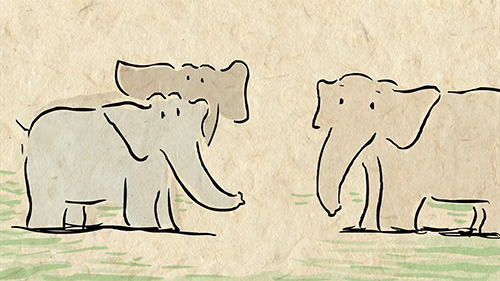
1. Elephants know every member of their herd and are able to recognize up to 30 companions by sight or smell.
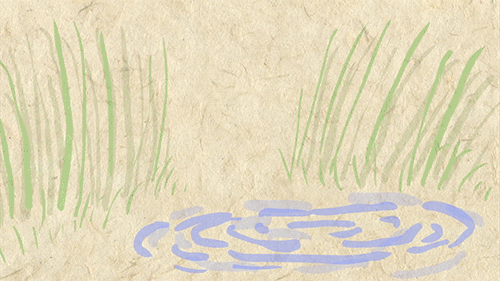
2. They can remember and distinguish particular cues that signal danger and can recall locations long after their last visit.
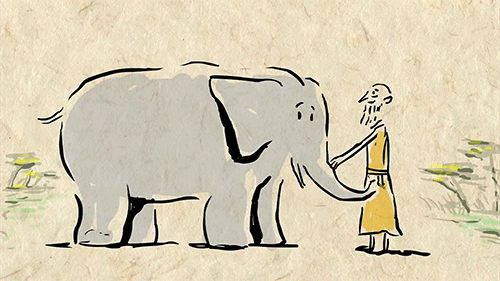
3. An elephant’s memory is not limited to its herd, nor is it limited to its species. In one instance, two circus elephants that performed together rejoiced when crossing paths 23 years later. Elephants have also recognized humans that they once bonded with after decades apart. 4.
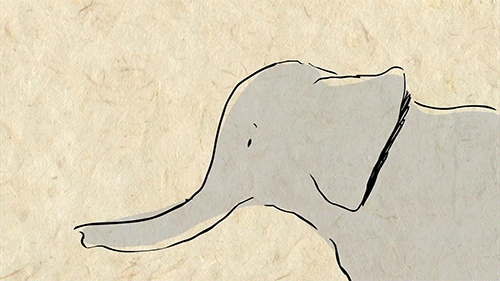
4. The elephant boasts the largest brain of any land mammal as well as an impressive encephalization quotient (the size of the animal’s brain relative to its body size). The elephant’s EQ is nearly as high as a chimpanzee’s.
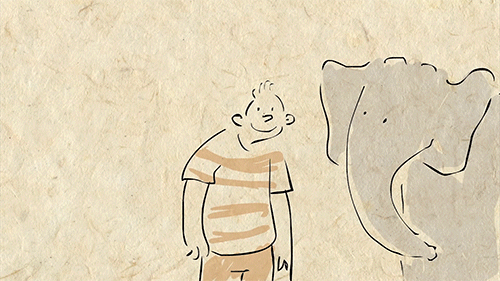
5. The elephant brain is remarkably similar to the human brain, with as many neurons and synapses, as well as a highly developed hippocampus and cerebral cortex.
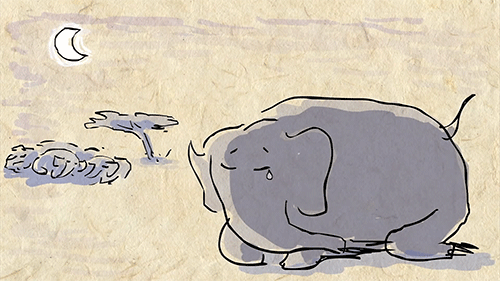
6. Elephants are one of the few non-human animals to suffer from post-traumatic stress disorder.

7. Elephants are creative problem solvers.
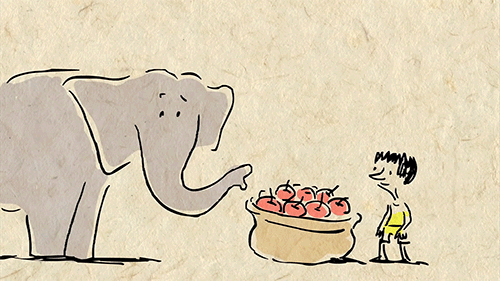
8. Don’t try to outsmart an elephant! They have an understanding of basic arithmetic and can even keep track of relative quantities.
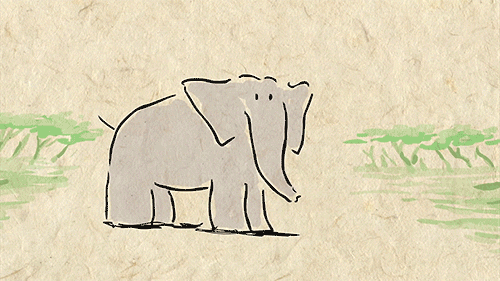
9. Elephants communicate using everything from body signals to infrared rumbles that can be heard from kilometers away. Their understanding of syntax suggests that they have their own language and grammar.
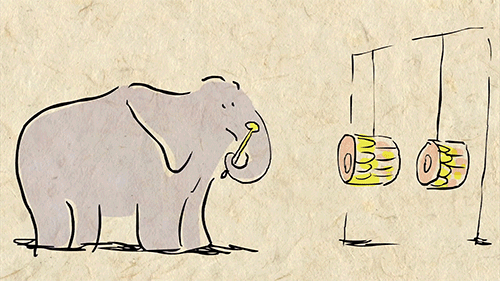
10. Elephants can recognize 12 distinct tones of music and recreate melodies.

11. Elephants are the only non-human animals to mourn their dead, performing burial rituals and returning to visit graves.
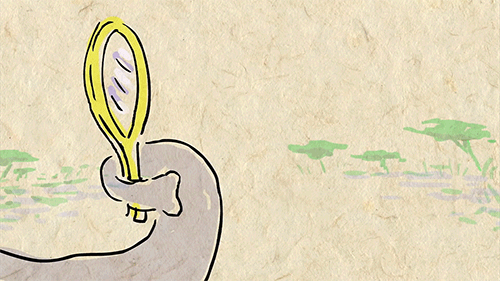
12. Elephants are one of the few species who can recognize themselves in the mirror.
Given what we now know about elephants, and what they continue to teach us about animal intelligence, it is more important than ever to make sure that these magnificent creatures do not vanish.
Check out some more fun elephant facts here and be sure to watch the TED-Ed Lesson Why elephants never forget - Alex Gendler
Animation by the ever-talented Avi Ofer

“The Mouse chirpeth… The Duck quaketh… The Wolf howleth” — from the very first picture book for children, published in 1658: http://buff.ly/2l6FaBH

Are humans the new supercomputer?
The saying of philosopher René Descartes of what makes humans unique is beginning to sound hollow. ‘I think – therefore soon I am obsolete’ seems more appropriate. When a computer routinely beats us at chess and we can barely navigate without the help of a GPS, have we outlived our place in the world? Not quite. Welcome to the front line of research in cognitive skills, quantum computers and gaming.
Today there is an on-going battle between man and machine. While genuine machine consciousness is still years into the future, we are beginning to see computers make choices that previously demanded a human’s input. Recently, the world held its breath as Google’s algorithm AlphaGo beat a professional player in the game Go—an achievement demonstrating the explosive speed of development in machine capabilities.
But we are not beaten yet - human skills are still superior in some areas. This is one of the conclusions of a recent study by Danish physicist Jacob Sherson, published in the prestigious science journal Nature.
”It may sound dramatic, but we are currently in a race with technology—and steadily being overtaken in many areas. Features that used to be uniquely human are fully captured by contemporary algorithms. Our results are here to demonstrate that there is still a difference between the abilities of a man and a machine,” explains Jacob Sherson.
At the interface between quantum physics and computer games, Sherson and his research group at Aarhus University have identified one of the abilities that still makes us unique compared to a computer’s enormous processing power: our skill in approaching problems heuristically and solving them intuitively. The discovery was made at the AU Ideas Centre CODER, where an interdisciplinary team of researchers work to transfer some human traits to the way computer algorithms work.
Quantum physics holds the promise of immense technological advances in areas ranging from computing to high-precision measurements. However, the problems that need to be solved to get there are so complex that even the most powerful supercomputers struggle with them. This is where the core idea behind CODER—combining the processing power of computers with human ingenuity—becomes clear.
Our common intuition Like Columbus in QuantumLand, the CODER research group mapped out how the human brain is able to make decisions based on intuition and accumulated experience. This is done using the online game “Quantum Moves”. Over 10,000 people have played the game that allows everyone contribute to basic research in quantum physics.
"The map we created gives us insight into the strategies formed by the human brain. We behave intuitively when we need to solve an unknown problem, whereas for a computer this is incomprehensible. A computer churns through enormous amounts of information, but we can choose not to do this by basing our decision on experience or intuition. It is these intuitive insights that we discovered by analysing the Quantum Moves player solutions,” explains Jacob Sherson.
The laws of quantum physics dictate an upper speed limit for data manipulation, which in turn sets the ultimate limit to the processing power of quantum computers—the Quantum Speed Limit. Until now a computer algorithm has been used to identify this limit. It turns out that with human input researchers can find much better solutions than the algorithm.
"The players solve a very complex problem by creating simple strategies. Where a computer goes through all available options, players automatically search for a solution that intuitively feels right. Through our analysis we found that there are common features in the players’ solutions, providing a glimpse into the shared intuition of humanity. If we can teach computers to recognise these good solutions, calculations will be much faster. In a sense we are downloading our common intuition to the computer” says Jacob Sherson.
And it works. The group has shown that we can break the Quantum Speed Limit by combining the cerebral cortex and computer chips. This is the new powerful tool in the development of quantum computers and other quantum technologies.
We are the new supercomputer
Science is often perceived as something distant and exclusive, conducted behind closed doors. To enter you have to go through years of education, and preferably have a doctorate or two. Now a completely different reality is materialising.
In recent years, a new phenomenon has appeared—citizen science breaks down the walls of the laboratory and invites in everyone who wants to contribute. The team at Aarhus University uses games to engage people in voluntary science research. Every week people around the world spend 3 billion hours playing games. Games are entering almost all areas of our daily life and have the potential to become an invaluable resource for science.
“Who needs a supercomputer if we can access even a small fraction of this computing power? By turning science into games, anyone can do research in quantum physics. We have shown that games break down the barriers between quantum physicists and people of all backgrounds, providing phenomenal insights into state-of-the-art research. Our project combines the best of both worlds and helps challenge established paradigms in computational research,” explains Jacob Sherson.
The difference between the machine and us, figuratively speaking, is that we intuitively reach for the needle in a haystack without knowing exactly where it is. We ‘guess’ based on experience and thereby skip a whole series of bad options. For Quantum Moves, intuitive human actions have been shown to be compatible with the best computer solutions. In the future it will be exciting to explore many other problems with the aid of human intuition.
"We are at the borderline of what we as humans can understand when faced with the problems of quantum physics. With the problem underlying Quantum Moves we give the computer every chance to beat us. Yet, over and over again we see that players are more efficient than machines at solving the problem. While Hollywood blockbusters on artificial intelligence are starting to seem increasingly realistic, our results demonstrate that the comparison between man and machine still sometimes favours us. We are very far from computers with human-type cognition,” says Jacob Sherson and continues:
“Our work is first and foremost a big step towards the understanding of quantum physical challenges. We do not know if this can be transferred to other challenging problems, but it is definitely something that we will work hard to resolve in the coming years.”
Once Upon a Time t
Once upon the time t(0) there was a young buck named Butterbean who wanted nothing more than to know his ontological value. Being familiar with the concepts of quantum mechanics he was sadly aware that this was theoretically impossible, but remained unsatisfied with the notion.

In an undying effort to discover the nature of his own existence he set out on a journey to seek the answer from all those most wise and perceiving.
Clearly the first stop was at the front door of Glad the hippopotamus.
Glad was of the notion that all things are ultimately mundane and that it is simply a matter of time and “progress” before esoteric conundrums become simple everyday knowledge. Surely this most assured creature could derive an unknown variable to discover the true nature of Butterbean himself. They were both of the mind at this time t(realist) that all the probabilistic nonsense was clearly just a cop out for those ninnies who fancied themselves finished with discovering the universe.

Alas after decades, or maybe days (no one can be sure given that time itself is a construct commonly defined as the duration of 9,192,631,770 periods of the radiation corresponding to the transition between the two hyperfine levels of the ground state of the cesium 133 atom, and who can really say cesium 133 even exists… really), Glad was forced to admit that he could not tell Butterbean of his ontological state prior to Butterbean’s arrival on his doorstep, nor could he possibly without any reference to his own experience as a literalist hippo, and was forced to admit that this coveted obscure variable was beyond his abilities of perception.
With a sense of hopelessness Butterbean sought out the comfort and guidance of Ol’ Trusty, the Wire Stripper. They adventured together for t(hedonist) to t(fundamentalist) without ever committing to any defined notion as after all, how can you find the answer to a paradox, oxymoron much?

However comfort in ignorance becomes unsettling after you’ve had your fun and Butterbean became restless. There was one more known avenue he had not yet travelled…
With a renewed sense of wonder and determination Butterbean approached the Oak, which shook its branches excitedly upon Butterbean’s arrival to see such a valiant seeker of answers. “Oak, what can you tell me about my ontological value?” asked Butterbean humbly. The Oak remained silent, but a slight breeze rustled loose a few leaves from its massive head which fluttered to the ground and landed lightly at Butterbean’s feet, Butterbean faltered and then turned and retreated thoughtfully sensing that the conversation was over.

Upon further consideration over Δt(orthodox) Butterbean understood Oak’s lesson— the leaves could change position through many methods all resulting in different outcomes, however before any leaf falls, it has not fallen. Butterbean had discovered that no matter who or what observes him, there would be an outcome, but it could not be these interactions which defined the whole of himself, surely he must be something inherently like the leaves of Oak’s mane.
One day, a little time later at approximately t(decision), Butterbean decided to venture forth in search of a method of measurement that excluded observation. Knowing that the existence of alligators had long been debated among those with a higher understanding of the nature of things, he knew he should seek within the mind of that which may or may not exist; namely an alligator (though a unicorn or manticore could have sufficed, they are not quite as easy to find nowadays).

Unfortunately all alligators are actually just dead trees and Butterbean had to once again rethink his strategy.
It occurred to Butterbean, after his most recent experiences, that perhaps his disbelief in alligators had caused their value to be null, distracted in hoping that his mind was not quite that powerful Butterbean mistakenly stomped on a daisy which let out a loud squeal, “watch out dummy!” “OH!” replied Butterbean, “Sorry I didn’t see you there, though come to think of it I’m surprised you even exist as I hadn’t yet observed you my friend.” The daisy straightened herself and smoothing out her petals scoffed and said jeeringly, “you think that you are the only one who exists, eh?” “Well,” began Butterbean thoughtfully, “no, but I don’t understand how anything or anyone has any sort of defined nature without something else purposefully interacting with it, after all, how do you know that you exist?” “Oh for goodness sake,” exclaimed young Daisy, “Of course you’ll remain limited as long as you keep collapsing your wave function with all that introspection!” And she turned her face to the sun clearly dismissing Butterbean and all his angsty questions.

Butterbean, with all known theories exhausted, was still unsatisfied and longed to know the mystery of his own nature of being and the recent dismissal of the daisy weighed heavy on his soul. “Why can she be so satisfied just being,” he wondered, “when I spend all of my time dedicated to the mystery and nature of life but still feel so empty and unfulfilled?” And suddenly it struck him! It had been so obvious all along and basically verbatim the retorts he had only just received from the annoyed flower he had trod on, Butterbean ceased to observe himself and existed infinitely in all possible states of being.

-
 lithiumliterature liked this · 7 months ago
lithiumliterature liked this · 7 months ago -
 philosophical-amoeba reblogged this · 7 years ago
philosophical-amoeba reblogged this · 7 years ago -
 the-halfbreed-hobbit reblogged this · 8 years ago
the-halfbreed-hobbit reblogged this · 8 years ago -
 a-spoon-is-born liked this · 8 years ago
a-spoon-is-born liked this · 8 years ago -
 medicineandart reblogged this · 8 years ago
medicineandart reblogged this · 8 years ago -
 catboard liked this · 8 years ago
catboard liked this · 8 years ago -
 niewychowana liked this · 8 years ago
niewychowana liked this · 8 years ago -
 izzy0317 liked this · 8 years ago
izzy0317 liked this · 8 years ago -
 arlathhan liked this · 8 years ago
arlathhan liked this · 8 years ago -
 forgetful-amoeba liked this · 8 years ago
forgetful-amoeba liked this · 8 years ago -
 nephastearchive liked this · 8 years ago
nephastearchive liked this · 8 years ago -
 sorchafariss-blog liked this · 8 years ago
sorchafariss-blog liked this · 8 years ago -
 niudl-blog liked this · 8 years ago
niudl-blog liked this · 8 years ago -
 woodsonresearchcenter liked this · 8 years ago
woodsonresearchcenter liked this · 8 years ago -
 iseesigils liked this · 8 years ago
iseesigils liked this · 8 years ago -
 nangoat liked this · 8 years ago
nangoat liked this · 8 years ago -
 yiriverfreezes-blog reblogged this · 8 years ago
yiriverfreezes-blog reblogged this · 8 years ago -
 yiriverfreezes-blog liked this · 8 years ago
yiriverfreezes-blog liked this · 8 years ago -
 airechan reblogged this · 8 years ago
airechan reblogged this · 8 years ago -
 airechan liked this · 8 years ago
airechan liked this · 8 years ago -
 batidodecabilla liked this · 8 years ago
batidodecabilla liked this · 8 years ago -
 deedwithoutname reblogged this · 8 years ago
deedwithoutname reblogged this · 8 years ago -
 mikeg-bean liked this · 8 years ago
mikeg-bean liked this · 8 years ago -
 loveforbooksandbinding reblogged this · 8 years ago
loveforbooksandbinding reblogged this · 8 years ago -
 lusca-deepseasun liked this · 8 years ago
lusca-deepseasun liked this · 8 years ago -
 quejamasdespierte liked this · 8 years ago
quejamasdespierte liked this · 8 years ago -
 yanagibayashi liked this · 8 years ago
yanagibayashi liked this · 8 years ago -
 class-wom liked this · 8 years ago
class-wom liked this · 8 years ago -
 heartfelt-elegy reblogged this · 8 years ago
heartfelt-elegy reblogged this · 8 years ago -
 xyzyyyzxz liked this · 8 years ago
xyzyyyzxz liked this · 8 years ago -
 maryhelencochranlibrary liked this · 8 years ago
maryhelencochranlibrary liked this · 8 years ago -
 upennmanuscripts reblogged this · 8 years ago
upennmanuscripts reblogged this · 8 years ago
A reblog of nerdy and quirky stuff that pique my interest.
291 posts














